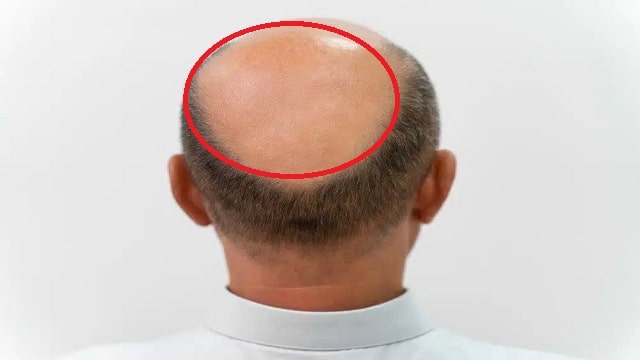Baldness
Baldness is a condition where hair falls out. This condition is usually permanent and is triggered by various things.
In fact, baldness occurs over time and is part of the aging process.
Baldness is a condition that can affect both men and women.
Symptoms of Baldness
In fact, the symptoms that occur in each person will be different, depending on the severity of the condition.
The symptoms that appear also depend on a person’s gender.
The following are the differences in baldness symptoms in men and women:
Man
Male pattern baldness is usually hereditary and can occur at any age.
Hair loss usually starts at the front, sides, or crown of the head. Some men only lose a few strands of hair.
However, some other men may lose all the hair on their heads.
Woman
Baldness in women is very rare. Unlike men, women only experience widening in certain parts of the head, such as the forehead.
Female pattern baldness rarely causes total hair loss.
Causes of Baldness
Baldness is the process of hair loss or complete absence of hair on the head.
This condition most often occurs on the scalp but can occur anywhere on the body that has hair.
Common underlying causes include:
- Part of the aging process.
- Hormonal changes in the body.
- Having certain diseases.
- Having a history of baldness in the family.
Apart from these common causes, baldness can occur due to several rarer conditions, such as:
1. Alopecia Areata
This disorder is characterized by sudden hair loss. Then, the lost hair in that area will grow back after a few months.
What you need to know is that hair growth will not occur if all the hair in the newly growing area suddenly falls out.
2. Toxic Alopecia
Toxic alopecia can occur after a high fever or severe illness.
This condition can also occur due to the consumption of certain medications, such as thallium, high doses of vitamin A, retinoids, and cancer drugs.
Thyroid disease can also trigger temporary hair loss.
4. Trichotillomania
This condition is another name for the habit of pulling hair.
If you do it continuously, trichotillomania can trigger hair loss and baldness.
Trichotillomania usually occurs in young children.
5. Scarring or Cicatricial Alopecia
Scarred areas can prevent hair from growing back. Scarring can occur from burns, injuries, or X-ray therapy.
However, other types of scarring can be caused by diseases, such as lupus, bacterial or fungal skin infections, lichen planus, sarcoidosis, tuberculosis, or skin cancer.
If hair loss occurs early, the condition usually gets worse over time if not treated with the right steps.
You need to know that hair loss does not occur due to poor circulation to the scalp, dandruff, and the habit of wearing hats.
Baldness Treatment
You can treat baldness with a hair replacement procedure.
However, a number of procedures cannot be performed on someone who is completely bald.
This is because the procedure requires hair on the back and sides of the head as hair donor areas.
Here are 4 hair replacement procedures to treat baldness:
1. Hair Transplant
Doctors can perform hair transplant procedures by taking small pieces of scalp containing hair from the back or side of the head as grafts.
The graft is then moved by the doctor to the bald or thinning area. Hair in the graft area will grow on its own.
2. Scalp Expansion
The doctor performs this procedure with a tissue expander, which he places under the hair-bearing area around the bald area.
After a few weeks, the tissue expander triggers the skin to grow new skin cells.
Then, the doctor will move the newly developed skin over the bald area.
3. Fold Operation
This surgery is ideal for covering large bald areas.
The doctor will perform this procedure by removing part of the bald area.
Then, the doctor will place a fold of skin containing hair on the bald area, with the ends attached to supply blood to the bald area.
4. Scalp Reduction
You can do scalp reduction to cover bald areas on the top and back of the head.
The procedure involves removing the bald scalp. Then, the hairy parts of the scalp are joined together to fill in the bald areas.
Baldness Prevention
As many as 40 men experience hair loss by the age of 35. To prevent it, you can take the following steps:
1. Take prescription drugs from a doctor
Doctors usually prescribe two types of drugs, namely finasteride and minoxidil.
Finasteride works by blocking the hormone dihydrotestosterone (DHT), which causes hair follicles to shrink and fall out.
Meanwhile, minoxidil functions to increase blood flow and absorption of nutrients to the follicles.
2. Use a Laser Comb
Aside from finasteride and minoxidil, laser combs are the only hair loss treatments that have received FDA approval.
To get the benefits, comb your scalp three times a week.
Low-power laser combs have an antioxidant effect on hair follicles.
3. Change Hair Care Products
Hair loss from hair care products occurs because the chemicals in them get trapped in the follicles. This can prevent hair from coming to the surface.
Apart from shampoo, conditioner or hair vitamins, you are also not advised to use excessive hair gel.
4. Don’t shower with hot water
Bathing with water that is too hot can trigger damage to the scalp.
Hot water can remove the natural oils that protect the scalp.
This triggers dryness and inflammation, which can lead to shrinking hair follicles and thinning hair.
5. Massaging the scalp
Massaging the scalp has the potential to increase hair density. This is due to increased blood circulation to the scalp and hair follicles.
This technique can increase the activity of genes that promote hair growth.
Another benefit is that it lowers a person’s stress levels.

